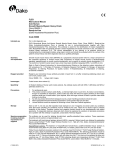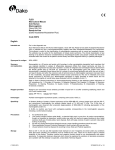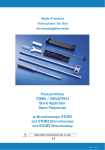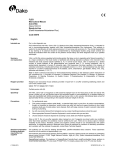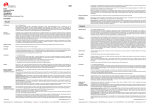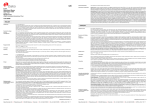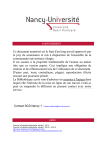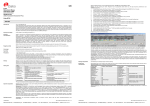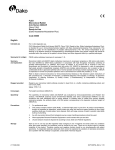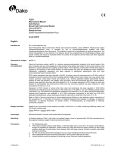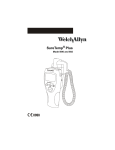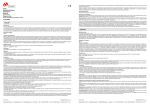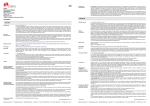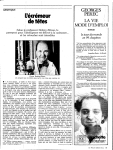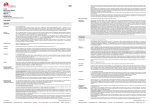Download Monoclonal Mouse
Transcript
FLEX Monoclonal Mouse Anti-Human Gross Cystic Disease Fluid Protein-15 Clone 23A3 Ready-to-Use (Dako Autostainer/Autostainer Plus) Code IS077 English Intended use For in vitro diagnostic use. FLEX Monoclonal Mouse Anti-Human Gross Cystic Disease Fluid Protein-15, Clone 23A3, Ready-to-Use (Dako Autostainer/Autostainer Plus), is intended for use in immunohistochemistry together with Dako Autostainer/ Autostainer Plus instruments. This antibody is useful for the identification of breast carcinoma and metastatic tumors of breast origin. The clinical interpretation of any staining or its absence should be complemented by morphological studies using proper controls and should be evaluated within the context of the patient's clinical history and other diagnostic tests by a qualified pathologist. Synonyms for antigen Summary and explanation GCDFP-15, extra-parotid glycoprotein (EP-GP), glycoprotein (gp17), prolactin-inducible protein (PIP), secretory actin binding protein (SABP) (1). GCDFP-15 is a 15 kDa monomeric secretory glycoprotein encoded by the PIP gene in the chromosome 7 q32-36 region (2, 3). GCDFP-15 is a marker of apocrine differentiation and is expressed in breast cystic fluid and in apocrine, lacrimal, ceruminous, Moll’s and eccrine glands. Serous cells of the submandibular, sublingual and minor salivary glands and of the nasal and bronchial glands also express GCDFP-15 (4). Using IHC, expression of GCDFP-15 has been observed in neoplastic cells from primary and metastatic tumors of the breast (1,5-8). Immunoreactivity has also been observed in carcinomas of the salivary gland, sweat gland, and prostate, whereas the majority of other malignancies evaluated were unreactive (7). Refer to Dako’s General Instructions for Immunohistochemical Staining or the detection system instructions of IHC procedures for: 1) Principle of Procedure, 2) Materials Required, Not Supplied, 3) Storage, 4) Specimen Preparation, 5) Staining Procedure, 6) Quality Control, 7) Troubleshooting, 8) Interpretation of Staining, 9) General Limitations. Reagent provided Ready-to-use monoclonal mouse antibody provided in liquid form in a buffer containing stabilizing protein and 0.015 mol/L sodium azide. Clone: 23A3. Isotype: IgG2a, kappa. Immunogen Recombinant protein corresponding to the excreted domain of the gross cystic disease fluid protein (15 kDa) molecule. Specificity In Western blotting of human MDA-MB-361 cell lysate, the antibody labels a 15 kDa band corresponding to the expected molecular weight of GCDFP-15. Precautions 1. 2. 3. 4. 5. Storage (118558-001) For professional users. This product contains sodium azide (NaN3), a chemical highly toxic in pure form. At product concentrations, though not classified as hazardous, sodium azide may react with lead and copper plumbing to form highly explosive build-ups of metal azides. Upon disposal, flush with large volumes of water to prevent metal azide build-up in plumbing. As with any product derived from biological sources, proper handling procedures should be used. Wear appropriate Personal Protective Equipment to avoid contact with eyes and skin. Unused solution should be disposed of according to local, State and Federal regulations. Store at 2-8 °C. Do not use after expiration date stamped on vial. If reagents are stored under any conditions other than those specified, the conditions must be verified by the user. There are no obvious signs to indicate instability of this product. Therefore, positive and negative controls should be run simultaneously with patient specimens. If unexpected staining is observed which cannot be explained by variations in laboratory procedures and a problem with the antibody is suspected, contact Dako Technical Support. 307724EFG_001 p. 1/8 Specimen preparation including materials required but not supplied The antibody can be used for labeling formalin-fixed, paraffin-embedded tissue sections. Tissue specimens should be cut into sections of approximately 4 µm. Pre-treatment with heat-induced epitope retrieval (HIER) is required. Optimal results are obtained by pretreating tissues using EnVision FLEX Target Retrieval Solution, High pH (10x), (Dako Autostainer/Autostainer Plus) (Code K8010/K8014). Deparaffinized sections: Pre-treatment of deparaffinized formalin-fixed, paraffin-embedded tissue sections is recommended using Dako PT Link (Code PT100/PT101). For details, please refer to the PT Link User Guide. Follow the pre-treatment procedure outlined in the package insert for EnVision FLEX Target Retrieval Solution, High pH (10x), (Dako Autostainer/Autostainer Plus) (Code K8010/K8014). The following parameters should be used for PT Link: Pre-heat temperature: 65 °C; epitope retrieval temperature and time: 97 °C for 20 (±1) minutes; cool down to 65 °C. Remove Autostainer slide rack with slides from the PT Link tank and immediately dip slides into a jar/tank (e.g., PT Link Rinse Station, Code PT109) containing diluted room temperature EnVision FLEX Wash Buffer (10x), (Dako Autostainer/Autostainer Plus) (Code K8010). Leave slides in Wash Buffer for 1-5 minutes. Paraffin-embedded sections: As alternative specimen preparation, both deparaffinization and epitope retrieval can be performed in the PT Link using a modified procedure. See the PT Link User Guide for instructions. After the staining procedure has been completed, the sections must be dehydrated, cleared and mounted using permanent mounting medium. The tissue sections should not dry out during the treatment or during the following immunohistochemical staining procedure. For greater adherence of tissue sections to glass slides, the use of Dako Silanized Slides (Code S3003) is recommended. Staining procedure including materials required but not supplied The recommended visualization system is EnVision FLEX, High pH, (Dako Autostainer/Autostainer Plus) (Code K8010). The staining steps and incubation times are pre-programmed into the software of Dako Autostainer/Autostainer Plus instruments, using the following protocols: Template protocol: FLEXRTU2 (200 µL dispense volume) or FLEXRTU3 (300 µL dispense volume) Autoprogram: GCDFP15 (without counterstaining) or GCDFP15H (with counterstaining) The Auxiliary step should be set to “rinse buffer” in staining runs with ≤10 slides. For staining runs with >10 slides the Auxiliary step should be set to “none”. This ascertains comparable wash times. All incubation steps should be performed at room temperature. For details, please refer to the Operator’s Manual for the dedicated instrument. If the protocols are not available on the used Dako Autostainer instrument, please contact Dako Technical Services. Optimal conditions may vary depending on specimen and preparation methods, and should be determined by each individual laboratory. If the evaluating pathologist should desire a different staining intensity, a Dako Application Specialist/Technical Service Specialist can be contacted for information on re-programming of the protocol. Verify that the performance of the adjusted protocol is still valid by evaluating that the staining pattern is identical to the staining pattern described in “Performance characteristics”. Counterstaining in hematoxylin is recommended using EnVision FLEX Hematoxylin, (Dako Autostainer/Autostainer Plus) (Code K8018). Non-aqueous, permanent mounting medium is recommended. Positive and negative controls should be run simultaneously using the same protocol as the patient specimens. The positive control tissue should include normal breast and the cells/structures should display reaction patterns as described for this tissue in “Performance characteristics” in all positive specimens. The recommended negative control reagent is FLEX Negative Control, Mouse, (Dako Autostainer/Autostainer Plus) (Code IS750). Staining interpretation The cellular staining pattern is cytoplasmic. Labeling of the secreted GCDFP-15 in the intercellular space may be observed. Performance characteristics Normal tissues: (118558-001) Tissue Type (# tested) Positively Staining Tissue Elements Adrenal (2) 0/2 Bone Marrow (1) 0/1 Brain/Cerebellum (3) 0/3 Brain/Cerebrum (3) 0/3 Breast (3) 2/3; Glandular and ductal cells, cytoplasmic Cervix (3) 0/3 Colon (3) 0/3 Esophagus (2) 0/2 Kidney (3) 0/3 Lung (3) Mesothelial cell (2) 0/3 0/2 Nerve, peripheral (2) 0/2 307724EFG_001 p. 2/8 Ovary (2) 0/2 Pancreas (3) 0/3 Parathyroid (1) 0/1 Pituitary (3) 0/3 Prostate (3) 0/3 Salivary gland (2) 2/2; Serous glands, cytoplasmic Skin (3) 3/3; Sweat glands, cytoplasmic Small Intestine (2) 0/2 Stomach (3) 0/3 Thyroid (3) 0/3 Tonsil (2) 0/2 Uterus (3) 0/3 Abnormal tissues: Moderate to strong diffuse or patchy staining was observed in 24/58 (41%) primary and metastatic breast carcinomas, with an additional 25 cases demonstrating weak and/or focal staining, bringing the overall sensitivity to 84.5%. In breast carcinoma tissue microarrays, the antibody demonstrated moderate to strong diffuse or patchy staining on 4/63 cores (6%), with an addition 8 cores exhibiting weak and/or focal staining with an overall sensitivity of 22% (9). Français Réf. IS077 Utilisation prévue Pour utilisation diagnostique in vitro. L’anticorps FLEX Monoclonal Mouse Anti-Human Gross Cystic Disease Fluid Protein-15, Clone 23A3, Ready-toUse (Dako Autostainer/Autostainer Plus), est destiné à être utilisé en immunohistochimie avec les appareils Dako Autostainer/Autostainer Plus. Cet anticorps facilite l’identification des carcinomes mammaires et des tumeurs métastatiques d’origine mammaire. L’interprétation clinique de toute coloration ou son absence doit être complétée par des études morphologiques en utilisant des contrôles appropriés et doit être évaluée en fonction des antécédents cliniques du patient et d’autres tests diagnostiques par un pathologiste qualifié. Synonymes de l’antigène GCDFP-15, glycoprotéine extra-parotidienne (EP-GP pour extra-parotid glycoprotein), glycoprotéine (gp17), protéine inductible par la prolactine (PIP pour prolactin-inducible protein), protéine sécrétoire de liaison à l’actine (SABP pour secretory actin binding protein) (1). Résumé et explication GCDFP-15 est une glycoprotéine sécrétoire monomérique de 15 kDa codée par le gène PIP situé dans la région chromosomique 7q32-36 (2, 3). GCDFP-15 est un marqueur de différenciation apocrine qui est exprimé dans le liquide provenant de kystes mammaires, ainsi que dans les glandes apocrines, lacrymales, cérumineuses, les glandes de Moll et les glandes eccrines. Les cellules séreuses des glandes salivaires sous-maxillaires, sublinguales et mineures, ainsi que celles des glandes nasales et bronchiques expriment également GCDFP-15 (4). L’expression de GCDFP-15 a été observée par IHC dans des cellules néoplasiques issues de tumeurs primitives et métastatiques du sein (1,5-8). Une immunoréactivité a également été observée dans des carcinomes de la glande salivaire, de la glande sudoripare et de la prostate, tandis que la majorité des autres malignités évaluées ne présentait aucune réactivité (7). Se reporter aux « Instructions générales de coloration immunohistochimique » de Dako ou aux instructions du système de détection relatives aux procédures IHC pour plus d’informations concernant les points suivants : 1) Principe de procédure, 2) Matériels requis mais non fournis, 3) Conservation, 4) Préparation des échantillons,5) Procédure de coloration, 6) Contrôle qualité, 7) Dépannage, 8) Interprétation de la coloration, 9) Limites générales. Réactifs fournis Anticorps monoclonal de souris prêt à l’emploi fourni sous forme liquide dans un tampon contenant une protéine stabilisante et 0,015 mol/L d’azide de sodium. Clone : 23A3. Isotype : IgG2a, kappa. Immunogène Protéine recombinante correspondant au domaine excrété de la molécule de GCDFP (15 kDa). Spécificité Lors de Western Blots de lysats de cellules humaines MDA-MB-361, l’anticorps marque une bande de 15 kDa correspondant au poids moléculaire attendu de GCDFP-15. Précautions 1. 2. 3. (118558-001) Pour utilisateurs professionnels. Ce produit contient de l’azide de sodium (NaN3), un produit chimique hautement toxique sous sa forme pure. Aux concentrations du produit, bien que non classé comme dangereux, l’azide de sodium peut réagir avec le cuivre et le plomb des canalisations et former des accumulations d’azides métalliques hautement explosifs. Lors de l’élimination, rincer abondamment à l’eau pour éviter toute accumulation d’azide métallique dans les canalisations. Comme avec tout produit d’origine biologique, des procédures de manipulation appropriées doivent être respectées. 307724EFG_001 p. 3/8 Conservation Préparation des échantillons y compris le matériel requis mais non fourni 4. Porter un vêtement de protection approprié pour éviter le contact avec les yeux et la peau. 5. Les solutions non utilisées doivent être éliminées conformément aux réglementations locales et nationales. Conserver entre 2 et 8 °C. Ne pas utiliser après la date limite de péremption indiquée sur le flacon. Si les réactifs sont conservés dans des conditions autres que celles indiquées, celles-ci doivent être validées par l’utilisateur. Il n’y a aucun signe évident indiquant l’instabilité de ce produit. Par conséquent, des contrôles positifs et négatifs doivent être testés en même temps que les échantillons de patients. Si une coloration inattendue est observée, qui ne peut être expliquée par un changement des procédures du laboratoire, et en cas de suspicion d’un problème lié à l’anticorps, contacter l’assistance technique de Dako. L’anticorps peut être utilisé pour le marquage des coupes de tissus inclus en paraffine et fixés au formol. L’épaisseur des coupes d’échantillons de tissu doit être d’environ 4 µm. Le prétraitement avec un démasquage d’épitope induit par la chaleur (HIER) est nécessaire. Pour obtenir des résultats optimaux, prétraiter les tissus à l’aide du produit EnVision FLEX Target Retrieval Solution, High pH (10x), (Dako Autostainer/Autostainer Plus) (réf. K8010/K8014). Coupes déparaffinées : Il est recommandé de prétraiter les coupes de tissus fixés au formol et inclus en paraffine qui ont été déparaffinées à l’aide de l’appareil PT Link de Dako (réf. PT100/PT101). Pour plus de détails, se reporter au Guide d’utilisation du PT Link. Suivre la procédure de prétraitement indiquée dans la notice du produit EnVision FLEX Target Retrieval Solution, High pH (10x), (Dako Autostainer/Autostainer Plus) (réf. K8010/K8014). Les paramètres suivants doivent être utilisés pour le PT Link : température de préchauffage : 65 °C ; température et durée du démasquage d’épitope : 97 °C pendant 20 (±1) minutes ; refroidissement jusqu’à 65 °C. Retirer le portoir à lames Autostainer contenant les lames de la cuve du PT Link et plonger immédiatement les lames dans un récipient/une cuve (par ex., station de rinçage du PT Link, réf. PT109) contenant du tampon de lavage EnVision FLEX Wash Buffer (10x), (Dako Autostainer/Autostainer Plus) (réf. K8010) dilué à température ambiante. Laisser les lames dans le tampon de lavage pendant 1 à 5 minutes. Coupes incluses en paraffine : Comme préparation alternative des échantillons, le déparaffinage et le démasquage d’épitope peuvent être réalisés dans l’appareil PT Link en utilisant une procédure modifiée. Consulter le Guide d’utilisation du PT Link pour obtenir des instructions. Une fois que la procédure de coloration est terminée, les coupes doivent être déshydratées, éclaircies et montées à l’aide d’un milieu de montage permanent. Les coupes de tissus ne doivent pas sécher lors du traitement ni lors de la procédure de coloration immunohistochimique suivante. Pour une meilleure adhérence des coupes de tissus sur les lames de verre, il est recommandé d’utiliser des lames Dako Silanized Slides (réf. S3003). Procédure de coloration y compris le matériel requis mais non fourni Le système de visualisation recommandé est le système EnVision FLEX, High pH, (Dako Autostainer/Autostainer Plus) (réf. K8010). Les étapes de coloration et les temps d’incubation sont préprogrammés dans le logiciel des appareils Dako Autostainer/Autostainer Plus, à l’aide des protocoles suivants : Protocole modèle : FLEXRTU2 (volume de distribution de 200 µL) ou FLEXRTU3 (volume de distribution de 300 µL) Programme automatique : GCDFP15 (sans contre-coloration) ou GCDFP15H (avec contre-coloration) L’étape Auxiliary doit être réglée sur « rinse buffer » lors des cycles de coloration avec ≤10 lames. Pour les cycles de coloration de >10 lames, l’étape Auxiliary doit être réglée sur « none ». Cela confirme des temps de lavage comparables. Toutes les étapes d’incubation doivent être effectuées à température ambiante. Pour plus de détails, se reporter au Manuel de l’opérateur spécifique à l'appareil. Si les protocoles ne sont pas disponibles sur l’appareil Dako Autostainer utilisé, contacter l’assistance technique de Dako. Les conditions optimales peuvent varier en fonction du prélèvement et des méthodes de préparation, et doivent être déterminées par chaque laboratoire individuellement. Si le pathologiste qui réalise l’évaluation désire une intensité de coloration différente, un ingénieur d’application/un spécialiste de l’assistance technique de Dako peut être contacté pour obtenir des informations sur la reprogrammation du protocole. Vérifier que les performances du protocole modifié sont toujours valides en vérifiant que le schéma de coloration est identique au schéma de coloration décrit à la section « Caractéristiques de performance ». Il est recommandé d’effectuer une contre-coloration à l’hématoxyline à l’aide du produit EnVision FLEX Hematoxylin, (Dako Autostainer/Autostainer Plus) (réf. K8018). L’utilisation d’un milieu de montage permanent non aqueux est recommandée. Des contrôles positifs et négatifs doivent être testés en même temps et avec le même protocole que les échantillons de patients. Le tissu de contrôle positif doit comprendre un sein sain et les cellules/structures doivent présenter des schémas de réaction semblables à ceux décrits pour ce tissu à la section « Caractéristiques de performance » pour tous les échantillons positifs. Le réactif de contrôle négatif recommandé est le produit FLEX Negative Control, Mouse, (Dako Autostainer/Autostainer Plus) (réf. IS750). Interprétation de la coloration (118558-001) Le schéma de coloration cellulaire est cytoplasmique. Un marquage de la protéine GCDFP-15 sécrétée peut être observé dans l’espace intercellulaire. 307724EFG_001 p. 4/8 Caractéristiques de performance Tissus sains : Type de tissus (nbre testés) Éléments tissulaires colorés positivement Surrénale (2) 0/2 Moelle osseuse (1) 0/1 Cerveau, cervelet (3) 0/3 Cerveau, hémisphères cérébraux (3) 0/3 Sein (3) 2/3 : cellules glandulaires et canalaires, cytoplasmiques Col de l’utérus (3) 0/3 Côlon (3) 0/3 Œsophage (2) 0/2 Rein (3) 0/3 Poumon (3) Cellules mésothéliales (2) 0/3 Nerf périphérique (2) 0/2 Ovaire (2) 0/2 Pancréas (3) 0/3 0/2 Parathyroïde (1) 0/1 Hypophyse (3) 0/3 Prostate (3) 0/3 Glande salivaire (2) 2/2 : glandes séreuses, cytoplasmiques Peau (3) 3/3 : glandes sudoripares, cytoplasmiques Intestin grêle (2) 0/2 Estomac (3) 0/3 Thyroïde (3) 0/3 Amygdale (2) 0/2 Utérus (3) 0/3 Tissus tumoraux : Une coloration diffuse ou inégale de manière modérée à forte a été observée dans 24 cas sur 58 (41 %) de carcinomes mammaires primitifs et métastatiques, avec 25 cas supplémentaires présentant une coloration faible et/ou localisée, portant la sensibilité globale à 84,5 %. Lors d’analyses réalisées sur des puces tissulaires de carcinomes mammaires, l’anticorps a présenté une coloration diffuse ou inégale de manière modérée à forte dans 4 carottes biopsiques sur 63 (6 %), avec 8 carottes biopsiques supplémentaires présentant une coloration faible et/ou localisée, avec une sensibilité globale de 22 % (9). Deutsch Code-Nr. IR077 Zweckbestimmung Zur In-vitro-Diagnostik. FLEX Monoclonal Mouse Anti-Human Gross Cystic Disease Fluid Protein-15, Klon 23A3, Ready-to-Use (Dako Autostainer/Autostainer Plus), ist zur Verwendung in der Immunhistochemie in Verbindung mit Dako Autostainer/Autostainer Plus-Geräten bestimmt. Dieser Antikörper dient zur Identifizierung von Brustkarzinomen und metastatischen Tumoren mit Ursprung in der Brust. Die klinische Auswertung einer eventuell eintretenden Färbung sollte durch morphologische Studien mit geeigneten Kontrollen ergänzt werden und von einem qualifizierten Pathologen unter Berücksichtigung der Krankengeschichte und anderer diagnostischer Tests des Patienten vorgenommen werden. Synonyme für das Antigen GCDFP-15, extra-parotid glycoprotein (EP-GP), Glykoprotein 17 (gp17), prolactin-inducible protein (Prolaktininduzierbares Protein, PIP), secretory actin binding protein (sekretorisches aktinbindendes Protein, SABP) (1). Zusammenfassung und Erklärung GCDFP-15 ist ein monomeres sekretorisches Glykoprotein von 15 kDa, das von dem auf Chromosom 7 in der Region q32-36 gelegenen PIP-Gen kodiert wird (2, 3). GCDFP-15 ist ein Marker der apokrinen Differenzierung und wird in Zystenflüssigkeit in der Brust sowie in apokrinen, ekkrinen, Ohrenschmalz-, Tränen- und Moll-Drüsen exprimiert. Auch die serösen Zellen der submandibulären, sublingualen and kleinen Speicheldrüsen sowie der nasalen und bronchialen Drüsen exprimieren GCDFP-15 (4). Mittels IHC wurde darüber hinaus eine Expression von GCDFP-15 in neoplastischen Zellen primärer und metastatischer Brusttumore beobachtet (1,5-8). (118558-001) 307724EFG_001 p. 5/8 Immunreaktivität wurde darüber hinaus bei Speicheldrüsenkarzinomen, Schweißdrüsenkarzinomen und Prostatakarzinomen beobachtet, wohingegen die Mehrzahl der anderen untersuchten Malignome keine Reaktion zeigte (7). Folgende Angaben bitte den Allgemeinen Richtlinien zur immunhistochemischen Färbung von Dako bzw. den Anweisungen des Detektionssystems für IHC-Verfahren entnehmen: 1) Verfahrensprinzip, 2) Erforderliche, aber nicht mitgelieferte Materialien, 3) Aufbewahrung, 4) Vorbereitung der Probe, 5) Färbeverfahren, 6) Qualitätskontrolle, 7) Fehlersuche und -behebung, 8) Auswertung der Färbung, 9) Allgemeine Beschränkungen. Geliefertes Reagenz Gebrauchsfertiger, monoklonaler Maus-Antikörper in flüssiger Form in einem Puffer, der stabilisierendes Protein und 0,015 mol/L Natriumazid enthält. Klon: 23A3. Isotyp: IgG2a, Kappa. Immunogen Rekombinantes Protein, das der exkretierten Domäne des Gross Cystic Disease Fluid Protein-Moleküls (15 kDa) entspricht. Spezifität Beim Western-Blotting von humanem MDA-MB-361-Zelllysat markiert der Antikörper eine Bande von 15 kDa, was dem erwarteten Molekulargewicht von GCDFP-15 entspricht. Vorsichtsmaßnahmen 1. 2. 3. 4. 5. Für Fachpersonal. Dieses Produkt enthält Natriumazid (NaN3), eine in reiner Form äußerst giftige Chemikalie. Natriumazid kann auch in als ungefährlich eingestuften Konzentrationen mit Blei- und Kupferrohren reagieren und hochexplosive Metallazide bilden. Nach der Entsorgung stets mit viel Wasser nachspülen, um Metallazidansammlungen in den Leitungen vorzubeugen. Wie alle Produkte biologischen Ursprungs müssen auch diese entsprechend gehandhabt werden. Geeignete Schutzkleidung tragen, um Augen- und Hautkontakt zu vermeiden. Nicht verwendete Lösung ist entsprechend örtlichen, bundesstaatlichen und staatlichen Richtlinien zu entsorgen. Lagerung Bei 2–8 °C aufbewahren. Nach Ablauf des auf dem Fläschchen aufgedruckten Verfalldatums nicht mehr verwenden. Werden die Reagenzien nicht entsprechend den angegebenen Bedingungen aufbewahrt, müssen die Bedingungen vom Anwender geprüft werden. Es gibt keine offensichtlichen Anzeichen für eine eventuelle Produktinstabilität. Positiv- und Negativkontrollen sollten daher zur gleichen Zeit wie die Patientenproben getestet werden. Falls es zu einer unerwarteten Färbung kommt, die sich nicht durch Unterschiede bei Laborverfahren erklären lässt und auf ein Problem mit dem Antikörper hindeutet, den technischen Kundendienst von Dako verständigen. Vorbereitung der Probe und erforderliche, aber nicht mitgelieferte Materialien Der Antikörper eignet sich zur Markierung von formalinfixierten und paraffineingebetteten Gewebeschnitten. Gewebeproben sollten in Schnitte von ca. 4 µm Stärke geschnitten werden. Es ist eine Vorbehandlung durch hitzeinduzierte Epitopdemaskierung (HIER-Verfahren) erforderlich. Optimale Ergebnisse können durch Vorbehandlung der Gewebe mit EnVision FLEX Target Retrieval Solution, High pH (10x), (Dako Autostainer/Autostainer Plus) (Code-Nr. K8010/K8014) erzielt werden. Entparaffinierte Schnitte: Die Vorbehandlung entparaffinierter formalinfixierter, paraffineingebetteter Gewebeschnitte sollte mit dem System Dako PT Link (Code-Nr. PT100/PT101) erfolgen. Weitere Informationen hierzu: siehe PT Link-Benutzerhandbuch. Die Vorbehandlung gemäß der Beschreibung in der Packungsbeilage EnVision FLEX Target Retrieval Solution, High pH (10x), (Dako Autostainer/Autostainer Plus) (Code-Nr. K8010/K8014) durchführen. Für das PT LinkSystem sollten die folgenden Parameter verwendet werden: Vorwärmtemperatur: 65 °C; Temperatur und Zeit für Epitopdemaskierung: 97 °C für 20 (±1) Minuten; auf 65 °C abkühlen. Das Autostainer Objektkträgergestell mit den Objektträgern aus dem PT Link-Behälter herausnehmen und die Objektträger sofort in einen Behälter (z. B. PT Link Rinse Station, Code-Nr. PT109) mit verdünntem, auf Zimmertemperatur gebrachten EnVision FLEX Wash Buffer (10x), (Dako Autostainer/Autostainer Plus) (Code-Nr. K8010) eintauchen. Die Objektträger für 1–5 Minuten im Wash Buffer belassen. Paraffineingebettete Schnitte: Alternativ können Entparaffinierung und Epitopdemaskierung im PT Link unter Verwendung eines modifizierten Verfahrens durchgeführt werden. Weitere Informationen finden Sie im PT LinkBenutzerhandbuch. Nach Abschluss des Färbeverfahrens müssen die Schnitte dehydriert, geklärt und unter Verwendung eines permanenten Fixiermittels fixiert werden. Die Gewebeschnitte dürfen während der Behandlung oder des anschließenden immunhistochemischen Färbeverfahrens nicht austrocknen. Zur besseren Haftung der Gewebeschnitte an den Glasobjektträgern wird die Verwendung von Dako Silanized Slides (Code-Nr. S3003) empfohlen. Färbeverfahren und erforderliche, aber nicht mitgelieferte Materialien Als Visualisierungssystem wird EnVision FLEX, High pH, (Dako Autostainer/Autostainer Plus) Code-Nr. K8010) empfohlen. Die Färbeschritte und Inkubationszeiten sind in der Software der Dako Autostainer/Autostainer PlusGeräte mit den folgenden Protokollen vorprogrammiert: Matrix-Protokoll: FLEXRTU2 (200 µL Anwendungsvolumen) oder FLEXRTU3 (300 µL Anwendungsvolumen) Autoprogramm: GCDFP15 (ohne Gegenfärbung) oder GCDFP15H (mit Gegenfärbung) Bei Färbedurchläufen mit höchstens 10 Objektträgern sollte der „Zusatz“-Schritt auf „Pufferspülgang“ eingestellt werden. Für Färbedurchläufe mit mehr als 10 Objektträgern den Zusatz-Schritt auf „Keine“ einstellen. Dies gewährleistet vergleichbare Waschzeiten. (118558-001) 307724EFG_001 p. 6/8 Alle Inkubationsschritte sollten bei Raumtemperatur durchgeführt werden. Nähere Einzelheiten bitte dem Benutzerhandbuch für das jeweilige Gerät entnehmen. Wenn die Färbeprotokolle auf dem verwendeten Dako Autostainer-Gerät nicht verfügbar sind, bitte den Technischen Kundendienst von Dako verständigen. Optimale Bedingungen können je nach Probe und Präparationsverfahren unterschiedlich sein und sollten vom jeweiligen Labor selbst ermittelt werden. Falls der beurteilende Pathologe eine andere Färbungsintensität wünscht, kann ein Anwendungsspezialist oder Kundendiensttechniker von Dako bei der Neuprogrammierung des Protokolls helfen. Die Leistung des angepassten Protokolls muss verifiziert werden, indem gewährleistet wird, dass das Färbemuster mit dem unter „Leistungsmerkmale“ beschriebenen Färbemuster identisch ist. Die Gegenfärbung in Hämatoxylin sollte mit EnVision FLEX Hematoxylin (Dako Autostainer/Autostainer Plus) (Code-Nr. K8018) ausgeführt werden. Empfohlen wird ein nichtwässriges, permanentes Fixiermittel. Positiv- und Negativkontrollen sollten zur gleichen Zeit und mit demselben Protokoll wie die Patientenproben getestet werden. Als positive Kontrolle sollte normales Brustgewebe verwendet werden, und die Zellen/Strukturen müssen in allen positiven Proben die für dieses Gewebe unter „Leistungsmerkmale“ beschriebenen Reaktionsmuster aufweisen. Das empfohlene Negativ-Kontrollreagenz ist FLEX Negative Control, Mouse, (Dako Autostainer/Autostainer Plus) (Code-Nr. IS750). Auswertung der Färbung Das zelluläre Färbemuster ist zytoplasmatisch. Es kann auch eine Färbung des sekretierten GCDFP-15 im interzellulären Raum beobachtet werden. Leistungsmerkmale Normales Gewebe: Gewebetyp (Anz. getestet) Gewebeelemente mit positiver Färbung Nebennieren (2) 0/2 Knochenmark (1) 0/1 Gehirn/Zerebellum (3) 0/3 Gehirn/Zerebrum (3) 0/3 Brust (3) 2/3; Glanduläre und duktale Zellen, zytoplasmatisch Zervix (3) 0/3 Kolon (3) 0/3 Speiseröhre (2) 0/2 Niere (3) 0/3 Lunge (3) Mesothelzellen (2) 0/3 0/2 Nerv, periphär (2) 0/2 Ovar (2) 0/2 Pankreas (3) 0/3 Nebenschilddrüse (1) 0/1 Hypophyse (3) 0/3 Prostata (3) 0/3 Speicheldrüsen (2) 2/2; Seröse Drüsen, zytoplasmatisch Haut (3) 3/3; Schweißdrüsen, zytoplasmatisch Dünndarm (2) 0/2 Magen (3) 0/3 Schilddrüse (3) 0/3 Mandeln (2) 0/2 Uterus (3) 0/3 Pathologisches Gewebe: Eine moderate bis stark diffuse oder fleckige Färbung wurde bei 24 von 58 (41%) primären und metastatischen Brustkarzinomen beobachtet, dazu bei 25 weiteren Fällen, die eine schwache und/oder fokale Färbung zeigten, was eine Gesamtsensitivität von 84,5% ergibt. In Microarrays von Brustkarzinomgewebe ergab der Antikörper eine moderate bis stark diffuse oder fleckige Färbung bei 4 von 63 Kernen (6%) und eine schwache und/oder fokale Färbung bei weiteren 8 Kernen, mit einer Gesamtsensitivität von 22% (9). (118558-001) 307724EFG_001 p. 7/8 References Bibliographie Literaturangaben 1. Fritzsche FR, Thomas A, Winzer KJ, Beyer B, Dankof A, Bellach J, Dahl E, Dietel M, Kristiansen G. Coexpression and prognostic value of gross cystic disease fluid protein 15 and mammaglobin in primary breast cancer. Histol Histopathol 2007;22:1221-30. 2. Caputo E, Carratore V, Ciullo M, Tiberio C, Mani JC, Piatier-Tonneau D, Guardiola J. Biosynthesis and immunobiochemical characterization of gp17/GCDFP-15. A glycoprotein from seminal vesicles and from breast tumors, in HeLa cells and in Pichia pastoris yeast. Eur J Biochem 1999;265:664-70. 3. Myal Y, Robinson DB, Iwasiow B, Tsuyuki D, Wong P, Shiu RP. The prolactin-inducible protein (PIP/GCDFP-15) gene: cloning, structure and regulation. Mol Cell Endocrinol 1991;80:165-75. 4. Viacava P, Naccarato AG, Bevilacqua G. Spectrum of GCDFP-15 expression in human fetal and adult normal tissues. Virchows Arch 1998;432:255-60. 5. Haagensen DE Jr. Is cystic disease related to breast cancer? [review]. Am J Surg Pathol 1991;15:687-94. 6. Mazoujian G, Bodian C, Haagensen DE Jr, Haagensen CD.Expression of GCDFP-15 in breast carcinomas. Relationship to pathologic and clinical factors. Cancer 1989;63:2156-61. 7. Wick MR, Lillemoe TJ, Copland GT, Swanson PE, Manivel JC, Kiang DT. Gross cystic disease fluid protein15 as a marker for breast cancer: immunohistochemical analysis of 690 human neoplasms and comparison with alpha-lactalbumin. Hum Pathol 1989;20:281-7. 8. Hall RE, Clements JA, Birrell SN, Tilley WD. Prostate-specific antigen and gross cystic disease fluid protein15 are co-expressed in androgen receptor-positive breast tumours. Br J Cancer 1998;78:360-5. 9. Bhargava R, Dabbs DJ. Use of immunohistochemistry in diagnosis of breast epithelial lesions [review]. Adv Anat Pathol 2007;14:93-107. Edition 04/08 (118558-001) 307724EFG_001 p. 8/8








